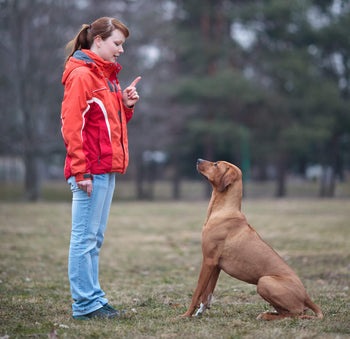Verbal VS. Hand Signals: Which is Best to Teach My Dog?

If you have ever gone to a dog obedience competition, you probably noticed that many handlers use hand signals instead of verbal. In fact hand signals seem to be the preferred signal by these competitors. Of course in agility, both hand and verbal are used. And in herding, verbal (voice or whistle) is almost solely used.
So is one better than the other? If you have a dog you are just starting to train, you may be unsure about what cues you should teach. To start, here are the pros and cons to each type of signal.
HAND SIGNALS
Pros
A 2016 study conducted by Dr. Biagio D’Aniello in the Biology Department at the University of Naples did a study on hand vs verbal signals and found that most dogs will respond more reliably to hand gestures over verbal. D’Aniello believes this is because dogs use their own body language as a way to communicate, so gestures are something they are naturally more inclined to notice and pay attention to, rather than human sounds.
If your dog goes deaf, you will still be able to communicate with them.
Since your dog has to be looking at you to get your cues, it may promote better focus/attention on you.
Cons
It can be hard to learn to be consistent with your cues. Dogs are very observant and slight changes in a cue can result in a nonresponse.
Because the cues have to be consistent, it can sometimes be hard to get the dog to listen to other people, who may not signal exactly the same way as you, so you have to teach your dog to generalize the cue a bit, to respond to gestures that are similar.
If your dog is out of sight, you can’t cue him.
If your dog goes blind, he will be unable to respond to your cues.
If your hands are full, you will not be able to cue your dog.
VERBAL SIGNALS
Pros
Your dog doesn’t have to be within eyesight to get your cue – for example you can call your dog to Come when he is wandering in the woods and he can hear you even if he can’t see you.
If your dog goes blind, you can still communicate with them.
You can cue your dog even if your hands are full – handy if you are holding your leash, clicker and treats, or if your hands are full of groceries and you need to communicate with your dog.
Cons
Since dogs are not naturally able to understand our language, it may take longer to get your dog to listen to your cues according to the above study.
If your dog goes deaf, you won’t be able to communicate with him.
The way you say your cue – tone, pitch, accent, etc. – will become part of the cue meaning your dog may not respond to someone else giving the cue if doesn’t sound the same. So you may have to spend some time teaching your dog to generalize the cue and respond to other peoples. (This is why dog trainers tell families that anyone who wants the dog to respond to them must practice with them!)
THE BEST CHOICE
As you can see, both hand and verbal has some solid pros and cons. So what’s the best choice? How about teaching both? Teaching your dog both a hand and a verbal eliminates any potential con, and provides all the pros of each signal.
IF YOU ARE GOING TO TEACH BOTH, TEACH THE VERBAL FIRST!
Why? Because as the study we mentioned says, dogs pay much better attention to body language, it is how they communicate. So if you teach a hand signal first and then try to add a verbal, it is much harder for your dog to make the connection because they are already focused on your body language. Especially after months of you rewarding them for reading your body language correctly!
Instead, start with teaching a verbal cue to a behavior. Once your dog has the behavior and the verbal cue is set, then start adding the hand signal.
How do I add a signal?
Adding a signal is simple. First, pick a signal that will be easy for you and others to repeatedly do the same. As an example, we will use the Sit cue. Here are the steps:
1. Make sure your dog is looking at you.
2. Use your new hand gesture and then almost immediately say your verbal cue.
3. Dog sits and gets a reward.
4. Repeat this a few times, then gradually lengthen the amount of time between the hand gesture and the verbal.
5. Watch your dog, is she starting to sit as you gesture or before you say the verbal? If so, she is starting to connect that the signal means the same as the verbal. You can now test it by just doing the gesture. Did she sit? If not, you will need to keep pairing the two for a bit more practice.
Since dogs pay attention to body language so well, adding hand gestures is usually pretty easy, even if the dog has been listening to verbal signals for quite some time. Having both will give you a lot more control of your dog and you won’t have to worry if your dog ends up not being able to see or hear you as he ages – it really is the best of both worlds.








